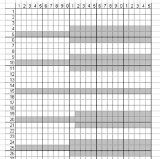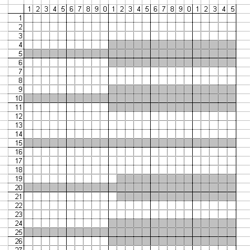
Shadow knitting
Encyclopedia
Shadow knitting, also called "illusion knitting", is a knitting
technique that produces patterns that vary with the direction of viewing.
 Each row in the pattern, shown in the thumbnail to the right, represents four rows of knit or purl stitches, and each column represents one stitch. To follow this pattern, a knitter would use black and white: white being the background color (BC), and black being the master color (MC).
Each row in the pattern, shown in the thumbnail to the right, represents four rows of knit or purl stitches, and each column represents one stitch. To follow this pattern, a knitter would use black and white: white being the background color (BC), and black being the master color (MC).
The visual effect of shadow knitting is due to the different height of the knit stitches on the wrong side rows. A knit stitch is flat, while a purl stitch is raised. Therefore, one can change which color (dark or light) stands out by changing from knit to purl. So the basic idea is to create a pattern in knit stitches in the colors one wants and purl stitches in the background color. When looking straight at the knitted piece, the stitches look approximately the same, but from an angle, only the raised purl stitches are visible.
There are no constraints on the position of the purl/knit stitches, so a nearly infinite variety of patterns can be made. The pattern will not be apparent from every direction of viewing, since one ridge may "overshadow" another. Knitters often enjoy watching when the picture created becomes visible. The stark contrast of alternating light and dark stripes is also visually interesting.
Extensions of the method include using more than two colors, or using other stitches; e.g., lace knitting
or cable knitting
.
Knitting
Knitting is a method by which thread or yarn may be turned into cloth or other fine crafts. Knitted fabric consists of consecutive rows of loops, called stitches. As each row progresses, a new loop is pulled through an existing loop. The active stitches are held on a needle until another loop can...
technique that produces patterns that vary with the direction of viewing.
Method
Despite its impressive effect, shadow knitting is a simple technique. As in mosaic knitting, the knitter alternates between two colors. Colors with good contrast are preferred, but are not required. The knitter knits two rows of color A, then two rows of color B, and repeats this throughout the body of the work. Only knit or purl stitches are used.
- Start at row one. This could be thought of as Row 1-1 and is a right-side row (RS).
- Row 1-1 (RS): With BC, knit.
- Row 1-2 (still following the pattern at row 1) (WS): Knit the blank boxes, purl the ones filled in.
- Row 1-3 (RS): Change to MC, knit.
- Row 1-4 (WS): Purl the blank boxes, knit the ones filled in.
- Move to Row 2 on the pattern and begin knitting the BC. (This is row 2-1.) Repeat for all rows and bind off.
The visual effect of shadow knitting is due to the different height of the knit stitches on the wrong side rows. A knit stitch is flat, while a purl stitch is raised. Therefore, one can change which color (dark or light) stands out by changing from knit to purl. So the basic idea is to create a pattern in knit stitches in the colors one wants and purl stitches in the background color. When looking straight at the knitted piece, the stitches look approximately the same, but from an angle, only the raised purl stitches are visible.
There are no constraints on the position of the purl/knit stitches, so a nearly infinite variety of patterns can be made. The pattern will not be apparent from every direction of viewing, since one ridge may "overshadow" another. Knitters often enjoy watching when the picture created becomes visible. The stark contrast of alternating light and dark stripes is also visually interesting.
Extensions of the method include using more than two colors, or using other stitches; e.g., lace knitting
Lace knitting
Lace knitting is a style of knitting characterized by stable "holes" in the fabric arranged with consideration of aesthetic value. Lace is sometimes considered the pinnacle of knitting, because of its complexity and because woven fabrics cannot easily be made to have holes...
or cable knitting
Cable knitting
Cable knitting is a style of knitting in which textures of crossing layers are achieved by permuting stitches. For example, given four stitches appearing on the needle in the order ABCD, one might cross the first two the next two, so that in subsequent rows those stitches appear in the new order...
.

